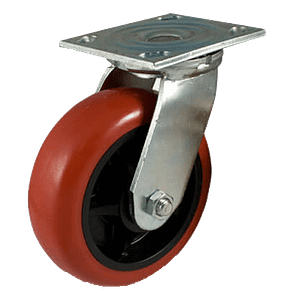Home » Technical Resources » Technical Library » Traditional Kingpin vs Kingpinless Swivel Casters
Swivel casters come in two distinct styles: traditional and kingpinless. In function, they are identical, both providing directional control of the cart. However, this is where the similarity ends, in design and form they are very different.
Traditional swivel sections are composed of several pieces: a top plate, a kingpin, a lower (thrust) race, a lower (thrust) bearing, an upper (load) race, and an upper (load) bearing. The kingpin, which is generally a bolt or rivet, holds the other five components together allowing the caster to swivel. The swivel action is centered about the kingpin. Legs are attached to the bottom side of the upper race, the lower race and bearing serve as a strengthening element, necessary to keep a heavier duty caster together. The illustration to the right depicts the basic construction of a traditional swivel section.
This construction technique, albeit tried and true, is not without its share of problems. Those problems generally stem from the kingpin. As stated before, the kingpin keeps the swivel section together and attaches it to the top plate. Therefore, with it being the joining element, the force the caster absorbs will be transmitted through the kingpin. With that in mind, the abuse will be focused on the kingpin and it will become strained and stressed over time.
Generally speaking, there are two situations where a rapid failure of a traditional swivel caster occurs. First and foremost is towing. Unless specifically designed for towing with heavy-duty bearings in the swivel section, most traditional swivel casters will fail when being towed. This predominately occurs because of high-speed cornering. High speed is, of course, a relative term. Casters are generally rated for loads at a walking speed, about 2 to 3 miles per hour. So, being towed at 5-6 miles per hour and taking a turn reduces the load bearing capacity significantly. The reason for this is a deformation of the swivel section. There are two component forces acting on the swivel section during a turn. Momentum keeps the cart going in the initial direction and the new force; that of the tugger turning, combine to create a composite force that tilts the wheel in the rig. This force can cause the kingpin to shear and the caster to fail catastrophically.
Secondly, traditional swivel casters fail because of shock loading or rough terrain. Realistically, dropping a load on a cart or taking it across a rough surface, they are identical to the caster. As the caster is impacted, either from the floor or from the dropping of a load, the kingpin takes the abuse. When the load increases the force is transmitted through the caster, however, as the impact occurs the wheel and the legs resist the force and it is isolated in the kingpin. Over time the kingpin after many impacts will deform, either in length or circumference. When this deformation occurs to a great enough extent the swivel section will seize because the ball bearings will become captured between the race and the plate. Or, in more extreme cases, the swivel section will separate enough to allow the ball bearings to escape.


Compared to the traditional swivel section, a kingpinless swivel section is by far much simpler. It is constructed of a top plate with a forged inner race, an outer race to which the legs are attached and the ball bearings between the two pieces. This design completely eliminates the need for a kingpin, as the name kingpinless implies. As depicted in the illustration to the right, the construction is straightforward.
Removing the kingpin all but eliminates the problems discussed above. Obviously, though, it isn’t quite that simple. The reason for the enhanced durability and performance lies in load distribution.
Consider the towing application, using a traditional swivel caster can lead to shearing of the kingpin and catastrophic failure of the caster. By utilizing this design, the load that is placed on the caster is distributed over a greater surface area. A kingpin, on average is about 5/8” in diameter, giving roughly a 2” circumference about which the load is distributed. Comparing that to a kingpinless swivel section which as a diameter of about 2”, giving a circumference of over 6”, the difference is obvious.
The same applies to the shock loading scenario. As the load is impacting the caster, or the caster to the floor, the greater impact area gained by the kingpinless design allows for the caster to absorb more force without failure.
Beyond a technical aspect of greater resistance to abuse and better performance, kingpinless casters offer a highly cost competitive alternative to traditional towing casters. The use of common ball bearings as opposed to a sealed precision ball or a tapered bearing makes the price highly attractive, without sacrificing capacity or durability.


Kingpinless casters provide an excellent alternative to traditional swivel casters in applications where high impact is the norm. The technical advantage of kingpinless casters combined with their cost competitiveness makes them an excellent choice for many applications.

Enter your name and email address to subscribe to our newsletter featuring the latest in material handling and storage solutions (opt out at anytime).